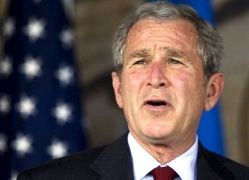World must end Darfur conflict – US Bush
February 19, 2008 (KIGALI ) — President George W. Bush paid somber homage Tuesday to the estimated 800,000 killed in Rwanda’s 1994 genocide and urged global action to end the bloodshed in Sudan’s Darfur region “once and for all.”

Bush, mid-way through a five-country Africa tour, announced he was freeing up 100 million dollars (68 million euros) for African peacekeeping efforts in the restive Sudanese province of Darfur but firmly defended his decision not to send US troops there.
“I made a decision and I stand by it,” he said with Rwandan President Paul Kagame at his side. “I’m comfortable with the decision I made, I’m not comfortable with how quickly the (international) response has been.”
Bush underlined Kagame’s decision to contribute peacekeepers for Darfur and declared: “My message to other nations is: ‘Join with the president and help us get this problem solved once and for all.'”
“And we will help. We will help through sanctions. We’ll help through pressure. We’ll help provide money to get these forces in, in an effective manner,” he promised.
Bush said the UN response to Darfur “seems very bureaucratic to me, particularly with people suffering,” and warned countries reluctant to impose sanctions on Sudanese leaders “human suffering ought to preempt commercial interests” — an apparent reference to China, a key Sudan partner.
According to the UN, about 200,000 people have died in Darfur from the combined effects of war, famine and disease since 2003, when a civil conflict erupted pitting government-backed Arab militias against non-Arab ethnic groups.
The US president, who has called the conflict “genocide,” later referred to the memorial in Kigali as a “holocaust museum.”
“It’s a moving place that can’t help but shake your emotions to their very foundation,” he declared after laying a wreath near a set of mass graves that memorial officials say hold remains from 258,000 people.
“It reminds me that we must not let these kinds of actions take place, and that the people of Rwanda need help to reconcile and move forward after a brutal period,” he said, with US First Lady Laura Bush at his side.
Museum officials walked reporters past the displays that Bush was to see during his visit, including a darkened room with skulls and femurs in lighted glass cases and a devastating display on children killed in the violence.
Patrick Gashugli Shimirwa, a five-year-old with a striped t-shirt, smiles broadly from one of the large black and white photos of some of the genocide’s youngest victims, above a plaque that describes the life taken from him.
Favorite sport: Riding his bicycle. Favorite food: Meat with fries and eggs. Best Friend: His sister, Alliane. Personality: Very calm, a well-behaved boy. Cause of death: Hacked apart with a machete, says the plaque.
Down the hall sit cases of rifles and machetes, a room filled with victims’ photographs dangling from wires, and tributes to other large-scale massacres, including the Holocaust and Cambodia’s Killing Fields.
Bush and Kagame later signed a bilateral investment treaty before the US president was to travel onward to Ghana and Liberia. He has already been to Benin and Tanzania.
Bush’s visit to Rwanda came 10 years after predecessor Bill Clinton, US president at the time of the genocide, travelled here to apologise for not doing enough to halt the violence.
(AFP)
